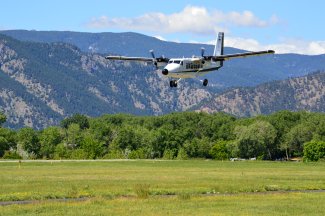Flight Box Design

NEON plane landing at the Boulder, CO airport. Photo credit: Colin Williams
The AOP remote sensing system takes advantage of the strong synergy between imaging spectroscopy and lidar to measure plant canopy biogeochemistry and habitat structure characteristics around NEON sites. Invasive plants can be detected both through their spectral properties and their structural properties. Pest and pathogen outbreaks, changes in competitive relations, responses to disturbances like wildfire, and many features of land use are readily observed and quantified using the powerful combination of biochemical and structural information provided by spectroscopy and waveform lidar (Kampe et al. 2010).
Up-scaling of both in situ measurements and airborne observations to continental scales requires a flight sampling design that: 1) covers the "area-of-influence" associated with cumulative eddy covariance flux tower observations and field measurements; 2) captures landscape environmental representativeness and heterogeneity (e.g., ecological and topographic gradients); 3) is sensitive to temporal system variation (e.g., phenology); and 4) is large enough to capture the impacts of unanticipated disturbance events.
AOP Flight Box Design
Airborne survey boundaries (flight boxes) at each NEON site are designed to produce consistent datasets at nominal 1 m resolution from the NEON imaging spectrometer and lidar. Areas within flight boxes are acquired at NEON's terrestrial and aquatic sites in every two to five years during annual periods of 90% maximum foliage (peak greenness). The criteria used to design flight boxes over each site result in datasets with adequate spatial extent to support scaling of in situ data from the NEON Terrestrial Instrumented System (TIS), Terrestrial Observation System (TOS), Aquatic Instrumented System (AIS), and Aquatics Observation System (AOS) to regional scales. The criteria produce systematic "minimum size" datasets across sites and ecological gradients, enabling robust statistical analysis for continental-scale modeling. The criteria also promote data acquisition efficiency by assigning flight boxes within an airborne survey area to either a high (Priority 1) or low (Priority 2) acquisition priority, providing airborne sensor operators with greater flexibility in the event that poor weather conditions prevent 100% data acquisition during an annual survey at a site.
A minimum flight box of 10 km x 10 km is flown over each terrestrial site. The flight box is initially centered over the NEON tower but repositioned as necessary to capture the tower airshed and TOS sampling boundary in their entirety. Because a small percentage of airflow from outside of the tower airshed will interact with the tower sensors, it is important to enable characterization of the vegetation/land cover for these non-airshed areas with AOP observations; thus, a minimum of 2 km distance is maintained between the tower and the edge of the airborne survey area. The placement of the minimum 10 km x 10 km airborne survey area is further repositioned or expanded to include the upstream watersheds of the TOS boundary and aquatic site, and to capture ecologically relevant areas immediately adjacent to the TOS boundary that are important to acquire because of their potential impacts on the TOS sampling area. Additionally, predominant land cover patterns, climate patterns, or ecological gradients that are relevant to domain-specific science themes and continental scale modeling will be considered for inclusion in the flight box.

Priority 1 and priority 2 flight boxes for Harvard Forest (HARV)
Viewing and Accessing Flight Boxes
Flight boxes can be viewed in the field site map on the Explore Field Sites webpage. To download the flight boxes, visit the Spatial Data & Maps webpage, where polygon flight boxes can be downloaded as a shapefile or KMZ file. These files include flight boundaries for aquatic and terrestrial field sites at all sites in NEON Domains D01 to D19. Please note that flight boundaries may change from year to year. Contact us for the most current plans and to coordinate research activities on the ground.